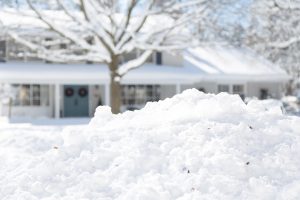When it snows, most people focus on driving conditions and shoveling sidewalks. Severe snowfall or snow that collects in areas around your home should also be on everyone’s mind as winter approaches. Anything that can block HVAC vents or the intake/exhaust pipe to your furnace or water can cause significant damage to those systems.
There are two things to realize when it comes to the snow’s effect on your furnace or water heater.
Cold weather and snow can cause your system to excessively cycle, which raises your utility bills and puts added wear on the air filters, requiring them to be replaced more frequently. This can also damage the components. The other issue is with the intake or exhaust pipe for your furnace or water heater.
Why keeping intakes and exhaust pipes clear of snow is important
Many people heat their homes with a gas furnace, which requires combustion to work. The byproducts caused by this process require venting, either through a flue or with the help of a fan pushing the gasses and other byproducts outside of the house. Water heats require a similar venting system to function properly. The problem with snow is that it can pile up and block these crucial airways, which can have a range of effects on your heating system.

- Exhaust vents/intakes become plugged or inoperable
- Increased wear on your water heater or furnace
- Build-up of carbon monoxide and other dangerous byproducts may become trapped in the home
Even for those with a high-efficiency furnace, you’ll still have to worry about your vents from becoming plugged with snow because a high-efficiency model will need to pull fresh air from the outside for combustion. Generally speaking, the intake pipes on such furnaces are supposed to be installed above the snow line, but improper installation could cause the intake to become buried or blocked by snow.
When these important air-intakes are block, your heating systems can stall. This is because these appliances require oxygen and when they don’t get it they will either stall or shut off if there’s a built-in safety mechanism. When the exhaust vent is covered with snow then something called a snow cave might form before the system has a chance to shut down. Snow caves can trap exhaust fumes and push them back into the house, dumping toxic substances into your living space over time.
Whether there’s a large snowfall or enough wind, snow can easily become a nuisance bigger than you realize. You can remove the snow yourself with a shovel or snowblower, but the key is to keep an eye on your exterior exhaust vents and intakes to prevent any snow from building up around these vital entry points. You could also install an A-frame over your exhaust vents or intakes, which can push snow away opposed to letting the snow settle on top or in front.
How to deal with snow-related exhaust vent or intake problems
Aside from managing the snow yourself each morning during the winter or installing an A-frame around your vents, you can also call a heating and cooling specialist. They’ll be able to walk you through best practices for preventative care for your furnace or water heater when snow is involved. If it’s been snowing and you’re experiencing problems with your heating, they’ll also be able to help you remedy the situation and aid you in figuring out how to prevent snow from blocking your exhaust vents or air intakes.
